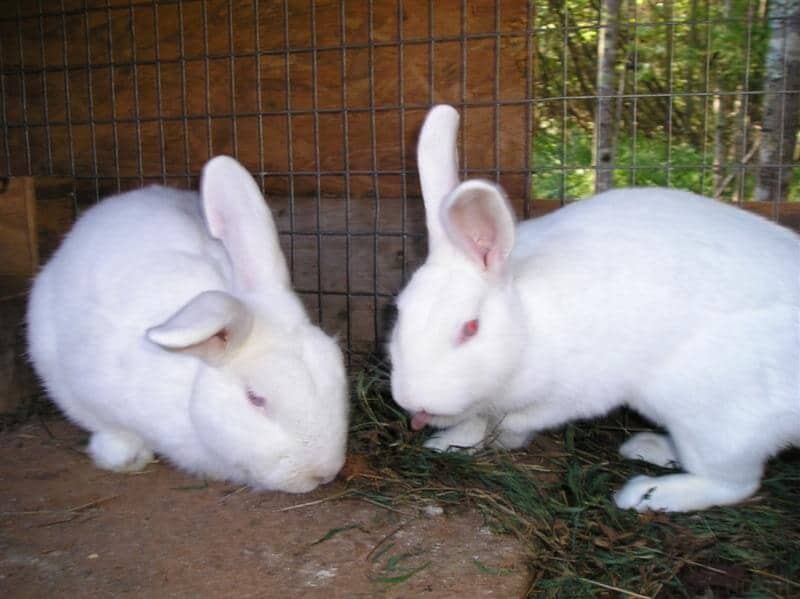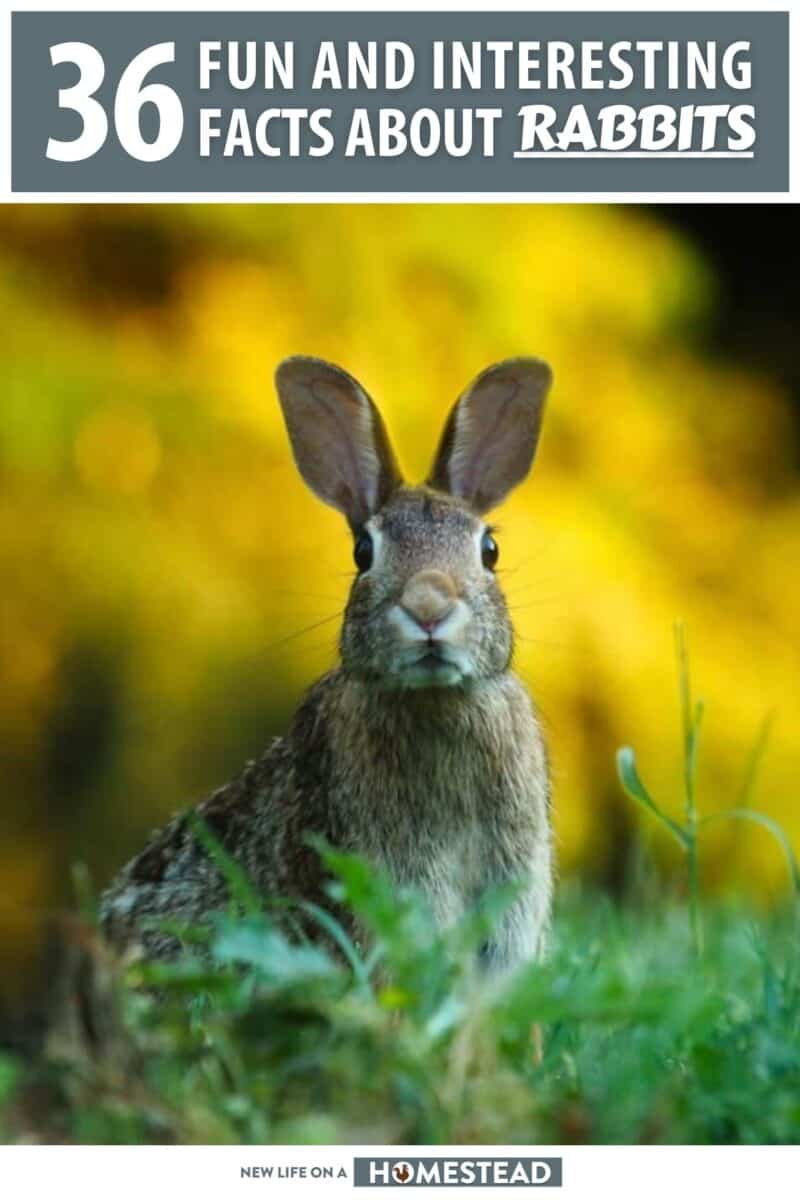Rabbits are one of those animals that just get taken for granted. When you see them sitting there silently chewing away on grass or hay, it’s easy to think they are dull, even dumb. But nothing could be further from the truth!

Rabbits, like all creatures, are surprisingly interesting, full of depth and wonder. From their social structure to their incredible physiology, rabbits can definitely surprise you if you take the time to learn about them… Keep reading and I will tell you some fun facts all about rabbits!
1. Rabbits Purr When Happy
Rabbits are much like cats in the way that they purr when they are happy and content.
Well, they don’t exactly purr the same way cats do, but rather they create a low humming noise that is similar to purring by rapidly chattering their teeth together; something called ‘bruxing’.
It isn’t harmful to the bunny, and when you hear it, you know they’re feeling good.
2. Rabbits Can See Nearly All Around Themselves
Rabbits possess a near 360-degree vision due to their eye’s positioning on the sides of their head.
This wide field of view allows them to spot predators from almost all directions, with only a small blind spot directly in front of their nose.
Their panoramic vision is an essential survival tool in the wild, as it allows them to maintain surveillance of the area without moving their head much.
3. Rabbits Rarely Blink
Speaking of a rabbit’s eyes, you’ll never stare one down: they rarely blink! Rabbits do not have much of a need to blink very often.
That may seem strange to us as we are always blinking, pretty much, but it is perfectly normal and natural for rabbits.
In fact, most rabbits only blink about one time every 5 minutes. Just try and see if you can do the same!
4. Rabbits Have an Excellent Nose
Rabbits possess remarkably sensitive noses, not only for sniffing out food but also for detecting potential threats and even find their friends and relatives.
This superb sense of smell is further enhanced by a constant twitching movement, which helps to draw in and analyze air continuously.
It’s a vital characteristic that makes rabbits even better survivors in the wild.
5. Rabbits Should Eat Mostly Hay
It is hay, not veggies, that form the core of a rabbit’s diet. Hay yields essential fiber that is critical for rabbit digestion and it also promotes healthy teeth.
Providing ample hay (preferably Timothy, Meadow, or Orchard grass hay) is critical for their overall well-being, though they need supplemental veggies and fruit, too.
6. Rabbits Mark Their Territory
Rabbits use scent to mark their spaces and their territory. This is usually done by rubbing their chins on items and the environment to leave behind a scent that’s unique to them.
Males are also notorious for spraying urine around their turf when they are sexually mature – done to deter other males from accessing their females.
This marking behavior helps signal ownership to other rabbits and plays a pivotal role in their social organization.
7. Rabbits Have Complex Social Interactions
Rabbits are hardly the simpletons most people seem to think they are. In actuality, they’re highly social creatures that engage in complex interactions and behaviors.
This includes, but is not limited to grooming each other, establishing dominance hierarchies (both males and females!), and playing with one another.
Even when kept as pets, rabbits should be given ample opportunities to interact socially with other rabbits and with you, or else they may become lonely.
8. Your Rabbit Wants Your Attention
Like I just said, you rabbit really does need good interactions with you.
They often crave the companionship of their owners, and that means lots of time spent on them – petting, grooming, playing etc. – as well as providing plenty of activities and toys to keep them mentally stimulated.
If your rabbit is acting out, it might just be trying to get your attention!
9. Male Rabbits Fight to Protect Their Females
Rabbits aren’t the snuggly pushovers you might think they are; they can actually be very protective of their mates!
Male rabbits (bucks) in particular take defending and protecting their female partners (does) very seriously, so much so that fights between males over a female are common.
Your male will even try to bite, scratch, or kick you if you come too close to his lady!
10. But it is Female Rabbits that are Territorial!
Bucks will go to war over the females, but the does will go to war over turf! Surprisingly, it’s female rabbits that tend to be more territorial than males.
When a doe feels her space is being invaded she will get aggressive and pushy towards the intruder, sometimes even if it’s a much larger animal or person. This is especially likely if the female is pregnant.
11. Pet Rabbits Can Live to Be 10 Years Old
Though rabbits in the wild only live a few years, pet rabbits can actually live as long as 10 years when given good care and nutrition.
This is because they’re kept safe from the dangers of the wild and diseases, and they receive proper care and nutrition that maximizes their lifespans.
With plenty of love and regular veterinary checkups, your rabbit will be with you for many years.
12. Female Rabbits Rarely Show Obvious Signs of Pregnancy
Ask anyone who’s owned rabbis long enough and they will tell you that female rabbits can surprise you completely with litters of bunnies that seem to come out of nowhere!
This pleasant or not-so-pleasant surprise happens because female rabbits rarely show obvious signs when they are pregnant.
Indeed, if you don’t know what you are looking for it can be almost impossible to tell until the babies arrive…
13. Female Rabbits Can “Fake” Pregnancy
To further complicate the mystery of rabbit pregnancy, does will also fake pregnancies by engaging in instinctive behaviors they would if they were actually pregnant.
Things like getting aggressive and standoffish, nest building, fur plucking and more are all common behaviors of “falsely pregnant” rabbits.
To truly know if your rabbit is pregnant, you’ll need to observe for movement in her tummy or take her to the vet.
14. Female Rabbits Deliver Babies in Just 30 Days
You probably know rabbits reproduce like, well, rabbits.
But, did you know they crank out a litter of 6 to 12 bunnies in just 30 days on average? That’s a fact!
The gestation period for rabbits is only about 30 days, so after the doe conceives, she’ll give birth in almost no time.
15. And Female Rabbits Can Get Pregnant Again in Hours!
If you thought that last fact was crazy, listen to this: a sexually mature and healthy doe can get successfully conceive another litter only hours after giving birth to her first.
This is because it is the act of mating that stimulates her to release eggs, not anything to do with her own hormonal cycles.
Plenty of new rabbit owners are letting dad in to see the kids after delivery- and then another batch is on the way!
16. Female Rabbits Can Abort Their Litters
An amazing, if sad, fact of rabbit pregnancy is that a mother rabbit can actually abort her litters if she is stressed by something in the environment or because of an overall poor state of health.
This usually happens as a lack of food in captivity. It’s sad, but nature has its own way, and sometimes the doe just won’t go through with it for whatever reason.
17. Rabbits Can Be Litterbox-Trained
You can train a pet rabbit to use a “litter box” just like you would a cat.
This is usually done by proving the rabbit with access to an appropriate litterbox and then rewarding it when it uses it correctly.
You’ll need rabbit-safe litter, though; cat litter is not good for rabbits.
18. Rabbits Cannot Vomit
Rabbits need to be seriously careful about what they eat; they cannot vomit, so any food they consume must pass through their systems.
Since a rabbit cannot regurgitate anything that might prove harmful, they are disproportionately vulnerable to illness and injury from food.
19. Rabbits Can Rotate Both Ears Independently
A rabbit’s ears are its most distinctive feature, and also one of the most important. Rabbit have great hearing and can rotate each of their ears independently.
This allows them to pinpoint the exact direction of a sound, meaning they rarely miss even the slightest noise or movement nearby.
20. Rabbits Have a Pre-chosen Escape Route
Part of what makes rabbits so quick on their feet is the fact that they plan ahead. Rabbits will always have a pre-chosen escape route from any given area they enter.
So when it’s time to flee, they can take off with decisiveness and speed to safety.
21. A Rabbit’s Tail is a Sort of a Decoy
Doesn’t it seem odd that a prey animal so dependent on hiding and going unnoticed to survive would have a bright white tail that sticks up in the air?
It is, at first glance, but a rabbit’s tail actually serves as a decoy, making predators indecisive as the rabbit jukes and jinks while running away.
22. Rabbits Live in Big Colonies
In the wild, you may only see one or two rabbits together in the open, but they actually live in big colonies underground, in dens called warrens.
A colony of rabbits will number anywhere from 10 to over 100 individuals, usually spread among family and close relations.
23. Bored Rabbits are Bad Rabbits
Domestic rabbits are sometimes notorious for going on destructive rampages around your house, chewing, gnawing and generally making a huge mess.
This often happens due to a lack of stimulation in their daily routing. Bunnies must have play and exercise, and a bored rabbit is an unhappy and destructive one.
Make sure to provide your furry friends with attention and toys, or face the consequences!
24. Rabbits and Hares Aren’t the Same Animal
Know the difference between a wild hare and a rabbit? They aren’t the same!
Rabbits are smaller, gentler animals that live in colonies and are pretty tame when raised as pets or livestock.
Hares, however, are solitary, have longer legs and ears, and entirely too wild to be kept as pets. Hares have actually never been domesticated!
25. Rabbits Need to Constantly Shorten Their Teeth
A rabbit’s teeth never stop growing. Ever. This is part of the reason why they love to chew on things; it shortens those impressive chompers.
It’s a serious medical issue for bunnies when their teeth overgrow, and it will affect their eating long before that, so make sure you provide them with the right foods and other things to gnaw.
26. Dusk and Dawn are the Most Active Times for Rabbits
Rabbits aren’t nocturnal, or diurnal. They are instead crepuscular, a term meaning most active at dawn and dusk.
That’s why you’ll see them often hopping around in the twilight hours, gathering food for themselves and their litters or just looking for mates.

27. Carrots Aren’t That Good for Rabbits – But Carrot Greens Are!
Time to put some sacred myths to rest! Carrots, despite what a cartoon rabbit might tell you, are not a rabbit’s favorite food.
They aren’t even really that good for them!
Where carrots are too high in carbs, carrot greens are a different story: these make a great meal for rabbits, and provide them with plenty of needed nutrients.
28. Baby Rabbits are Called Kittens
I put the sword to carrots, now I am telling you baby rabbits aren’t bunnies! It’s true. Baby rabbits are properly called kittens (or kits, like baby foxes).
I don’t know about you, but I’m so used to calling them bunnies I don’t know if I can break the habit…
29. “Bunny” is Just a Nickname for Any Rabbit
In fact, the term “bunny” doesn’t have anything to do with rabbits, not properly.
It is a term that is used as a nickname baby rabbits, but bunny used to be a slang term for an attractive young-lady, and somehow it just morphed into a term for rabbits generally and then baby rabbits.
30. Kittens are Born Blind and Furless
Speaking of baby bun- ahem, kittens, they are born blind and furless, totally defenseless. It takes around 10 days before a will open their eyes.
They usually sprout short, fuzzy fur around a week old.
31. Rabbits Can Leap Laterally Over 10 Feet!
Rabbits are famous the world over for their leaping ability. Most rabbits can jump 2 feet or more off the ground, but with a good start, they can clear a 10 foot lateral leap!
That’s pretty amazing when you consider how small they are.
32. Rabbits are Fastidiously Clean
Rabbits are like cats in one other essential way: their hygiene practices. Rabbits are fastidiously clean and will groom themselves several times a day.
They also spend time grooming others in their family or colony to build bonds between them.
33. Most Rabbits Don’t Like Being Picked Up
Rabbits are irresistibly cuddly to most folks- those ears, the fur, the little twitching nose! – but as tempting as it is to snuggle these little fuzzballs you really shouldn’t.
Rabbits generally don’t like to be picked up and held and most become anxious when lifted off the ground.
Even if your rabbit seems calm and happy while being carried, try not to do it too often.
34. Rabbits’ Ears Help Them Stay Cool
A rabbit’s ears provide more than just amazing hearing; they also help keep a rabbit cool in hot weather.
Those big ol’ ears are highly vascular and act as radiators, helping to regulate their body temperature during hot weather.
They also do the reverse, constricting bloodflow to help conserve body heat when it is cold out.
35. Rabbits Can Growl and Hiss When Angry
Rabbits aren’t silent. Far from it! They make all kinds of noises, including growling and hissing when they are angry or scared.
When a rabbit is irritated, it will often make a sort of grunting noise, and if you’ve really ticked it off, you can expect to hear some growling.
Rabbits will growl at you and also at each other when upset, so expect it from time to time and give them space.
36. Giving a Rabbit a Bath Might Kill It
Rabbits stay clean when left to their own devices, usually, but even if they do get dirty think twice before giving them a bath.
Rabbits can easily go into shock and die when submerged in water, both from panic and from a plunging body temperature, so it is rarely a good idea.
If you’re going to bathe your rabbit, you must follow a pretty strict procedure to keep them safe and comfortable.

Tom has lived and worked on farms and homesteads from the Carolinas to Kentucky and beyond. He is passionate about helping people prepare for tough times by embracing lifestyles of self-sufficiency.
